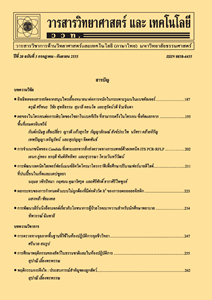การศึกษาคุณลักษณะของน้ำทะเลปนเปื้อนน้ำมันเมื่อผ่านกระบวนการแปรสภาพน้ำมันด้วยเทคนิค
Main Article Content
Abstract
Oil spill has been recognized as a major environmental problem. FEEM technique has been used to confirm the contamination of oil and oil products in natural water. However the weathering processes might cause a problem for confirmation of oil spill due to the change of oil physical and chemical compositions. We studied the characteristic of diesel and lubricant oil contaminated seawater during the weathering process. PAHs-like substances were found in all water samples but their characteristics have been changed through the study period due to the variation of fluorescence intensity. This variation was also specific to the type of PAHs substances. This also suggested that FEEM might be a potential tool for confirm the contamination of oil and oil products in natural condition.
Keywords: fluorescence spectroscopy; FEEM; oil weathering
Article Details
References
[2] กรมเจ้าท่า, สถิติน้ำมันรั่วไหล ปี 2559, แหล่งที่มา : http://www.md.go.th/md/ind ex.php/2014-01-19-05-02-28/2016-07-25-03-15-33/2016-11-23-07-40-37/2982--2559-352560, 20 มิถุนายน 2560.
[3] Patra, D., 2003, Applications and new developments in fluorescence spectro-scopic techniques for the analysis of polycyclic aromatic hydrocarbons, Appl. Spectros. Rev. 38: 155-185.
[4] Li, J., Fuller, S., Cattle, J., Way, C.P. and Hibbert, D.B., 2004, Matching fluorescence spectra of oil spills with spectra from suspect sources, Anal. Chim. Acta. 514: 51-56.
[5] Christensen, J.H. and Tomasi, G., 2007, Practical aspects of chemometrics for oil spill fingerprinting, J. Chromatogr. A 1169: 1-22.
[6] Bugden, J.B.C., Yeung, C.W., Kepkay, P.E. and Lee, K., 2008, Application of ultraviolet fluorometry and excitation-emission matrix spectroscopy (EEMs) to fingerprint oil and chemically dispersed oil in seawater, Mar. Pollut. Bull. 56: 677-685.
[7] Wang, H., Zhang, Y.Y. and Xiao, X., 2010, Quantification of polycyclic aromatic hydrocarbons in water: A comparative study based on three-dimensional excitation-emission matrix fluorescence, Anal. Sci. 26: 1271-1276.
[8] Ferretto, N., Tedetti, M., Guigue, C., Mounier, S. and Redon, R., 2014, Identification and quantification of known polycyclic aromatic hydrocarbons and pesticides in complex mixtures using fluorescence excitation-emission matrices and parallel factor analysis, Chemosphere 107: 344-353.
[9] Mendoza, W.G., Riemer, D.D. and Zika, R.G., 2013, Application of fluorescence and PARAFAC to assess vertical distribution of subsurface hydrocarbons and dispersant during the deepwater horizon oil spill, Environ. Sci. Proc. Impacts 15: 1017-1030.
[10] ชนชนก อรุณเลิศ, สุภกิจ จิ๋วเจริญ และมารุต สุขสมจิตร, 2557, การสืบหาแหล่งที่มาของสาร อินทรีย์ละลายน้ำบริเวณอ่าวประดู่และบริเวณใกล้เคียงนิคมอุตสาหกรรมมาบตาพุด จังหวัดระยอง โดยเทคนิค 3D EEM Fluorescence Spectroscopy, การประชุมวิชาการวิทยาศาสตร์ทางทะเล ครั้งที่ 4, น. 189, มหาวิทยาลัยสงขลานครินทร์, สงขลา.
[11] The International Tanker Owners Pollution Federation Limited, 2011, Fate of Marine Oil Spills: Technical Information Paper 2, United Kingdom, 12 p.
[12] Bugden, J.B.C., Yeung, C.W., Kepkay, P.E. and Lee, K., 2008, Application of Ultraviolet fluorometry and excitation-emission matrix spectroscopy (EEMS) to fingerprint oil and chemically dispersed oil in seawater, Mar. Pollut. Bull. 56: 677-685.
[13] Yan, Z., Sun, B., Yang, S., Liu, Y., Liu, H. and Wang, Q., 2014, Study of the characteris-tics of floating and sunken oil in seawater exposed to long term weathering, Open Petro. Eng. J. 7: 137-141.
[14] Davis, S.E., Corronado-Molina, C., Childers, D.L. and Day, J.W., 2003, Temporally dependent C, N, and P dynamics associated with the decay of Rhizophora mangle L. leaf litter in oligotrophic mangrove wetlands of the southern everglades, Aquat. Bot. 75: 199-215.
[15] Nagao, S., Suzuki, Y., Nakaguchi, Y., Senoo, M. and Hiraki, K., 1997, Direct measurement of the fluorescence characteristics of aquatic humic substances by a three-dimensional fluorescence spectrometer, Bunseki Kagaku 46: 335-342.
[16] มารุต สุขสมจิตร, ไตรเทพ วิชย์โกวิทเทน และกฤติฏิ์สุดา ภู่นาค, 2559, การศึกษาคุณลักษณะของสารอินทรีย์ละลายน้ำในแม่น้ำแม่กลองโดยใช้เทคนิค Fluorescence spectro-scopy, การประชุมวิชาการมหาวิทยาลัยเกษตร ศาสตร์ ครั้งที่ 54, น. 1131-1138, มหาวิทยาลัยเกษตรศาสตร์, กรุงเทพฯ.
[17] Stogiannidis, E. and Laane, R. 2015, Source characterization of polycyclic aromatic hydrocarbons by using their molecular indices: An overview of possibilities, Rev. Environ. Contam. T. 234: 49-133.
[18] Baszanowska, E., Zielinski, O., Otremba, Z. and Toczek, H., 2013, Influence of oil-in-water emulsions on fluorescence properties as observed by excitation-emission spectra, J. Europ. Opt. Soc. Rap. Public. 8: 13069-1 - 13069-5.
[19] Alostaz, M., Biggar, K., Donahue, R. and Hall, G., 2008, Petroleum contamination characterization and quantification using fluorescence emission excitation matrices (EEMs) and parallel factor analysis (PARAFAC), J. Environ. Eng. Sci. 7: 183-197.
[20] Zhou, Z., Liu, Z. and Guo, L. 2013, Chemical evolution of Macando crude oil during laboratory degradation as characterized by fluorescence EEMs and hydrocarbon composition, Mar. Pollut. Bull. 66: 164-175.
[21] Liu, Y., He, J., Song, C., Li, Y., Wang, S., Han, Y. and Wang, H., 2009, Oil fingerprinting by three-dimensional (3D) fluorescence spectroscopy and gas chromatography-mass spectrometry (GC-MS), Environ. Forensics 10: 324-330.


